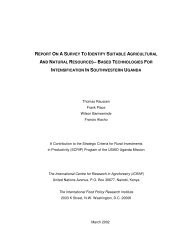Continuities in environmental narratives, Kabale, Uganda ... - Foodnet
Continuities in environmental narratives, Kabale, Uganda ... - Foodnet
Continuities in environmental narratives, Kabale, Uganda ... - Foodnet
Create successful ePaper yourself
Turn your PDF publications into a flip-book with our unique Google optimized e-Paper software.
access and d) enhanc<strong>in</strong>g household utilization of food, particularly by women and children.’ 103<br />
Africare notes that ‘the project started by undertak<strong>in</strong>g a basel<strong>in</strong>e survey <strong>in</strong> 1997 that revealed the<br />
magnitude of food <strong>in</strong>security <strong>in</strong> <strong>Kabale</strong> district.’ 104 In fact this basel<strong>in</strong>e survey did not even<br />
attempt to measure food <strong>in</strong>security, nor did it measure rates of nutrition or food production. 105<br />
Rather, the existence of food <strong>in</strong>security <strong>in</strong> the district was identified as an assumption of the<br />
survey, as well be<strong>in</strong>g one of the conclusions of the survey. 106 This can be seen as an extreme<br />
example of the ‘misuse’ of data to support policy decisions that have already been made, and<br />
adopt<strong>in</strong>g the familiar narrative Africare notes that ‘due to high population density and <strong>in</strong>tensive<br />
land cultivation, soil degradation has cont<strong>in</strong>ued to threaten food security <strong>in</strong> the district.’ 107<br />
Conclusion<br />
This paper has shown that the <strong>narratives</strong> that were established <strong>in</strong> the colonial period have<br />
cont<strong>in</strong>ued after Independence. The colonial legacy is apparent <strong>in</strong> the rhetoric around the<br />
environment <strong>in</strong> <strong>Kabale</strong> today, although this is rarely acknowledged. Indeed few references are<br />
made to colonial efforts around the environment. When reference is made to soil conservation<br />
measures <strong>in</strong>troduced <strong>in</strong> the colonial period it is to expla<strong>in</strong> that soil conservation measures have<br />
been abandoned s<strong>in</strong>ce Independence as these policies were associated with colonial rule. Thus,<br />
for example, it has been observed that<br />
There was a strong element of coercion <strong>in</strong> enforc<strong>in</strong>g conservation programmes <strong>in</strong> <strong>Kabale</strong><br />
…district dur<strong>in</strong>g the colonial era. This policy is partly responsible for subsequent neglect<br />
of conservation practices after <strong>in</strong>dependence, because the local communities did not<br />
identify with it, lead<strong>in</strong>g to the removal of terrace raisers. Erosion became very <strong>in</strong>tense as<br />
a result. 108<br />
But this misses the po<strong>in</strong>t that these measures were modifications to the <strong>in</strong>digenous system of<br />
agriculture and for this reason were not rejected by farmers. 109 Furthermore <strong>in</strong> colonial Kigezi<br />
significant efforts with regard to education and propaganda were made result<strong>in</strong>g <strong>in</strong> a high degree<br />
of understand<strong>in</strong>g of the reasons beh<strong>in</strong>d the policies. But these explanations of the reasons beh<strong>in</strong>d<br />
policies themselves rely on the Malthusian <strong>environmental</strong> degradation narrative and these have<br />
‘fed-back’ <strong>in</strong>to the local population. The very same phrases first used by colonial officials, and<br />
then by post-colonial officials have been adopted by the local population who repeat them back<br />
to development workers today. Thus, through a process of iteration, the narrative has become<br />
deeply embedded <strong>in</strong> the local population. This has major implications for policy, given the<br />
<strong>in</strong>creased focus on farmer participation, which means that the perceptions of local people carry<br />
more weight. The perceptions of farmers, as much as outsiders, are <strong>in</strong>fluenced by the narrative.<br />
Furthermore, the understandable desire to be chosen as recipients of development projects may<br />
encourage people to both say what they th<strong>in</strong>k development workers want to hear and to stress<br />
difficulties today compared to the past. Thus with the policies of participation and<br />
decentralization the tendency for these <strong>narratives</strong> to be perpetuated cont<strong>in</strong>ues.<br />
103<br />
Africare, ‘The Status of UFSI’, mimeo (2000), 2.<br />
104<br />
Africare, ‘The Status of UFSI’, mimeo (2000), 1.<br />
105<br />
Africare Basel<strong>in</strong>e Survey (1997), 45. The basel<strong>in</strong>e survey also did not measure – or attempt to assess – changes to<br />
forest cover, despite conclud<strong>in</strong>g that deforestation ‘widely practiced’.<br />
106<br />
Africare Basel<strong>in</strong>e Survey (1997), 3 and 45.<br />
107<br />
Africare Basel<strong>in</strong>e Survey (1997), 4.<br />
108<br />
NEMA, ‘The draft National Soils Policy for <strong>Uganda</strong>’ (1998), 13. See also NEMA, State of the Environment<br />
Report for <strong>Uganda</strong> 1998.<br />
109<br />
Carswell ‘Soil conservation policies <strong>in</strong> colonial Kigezi.’<br />
D:\_<strong>Uganda</strong> Land Use\SW land use and soils\Carswell papers\Carswell- Narratives paper-17 Dec.doc<br />
19
















